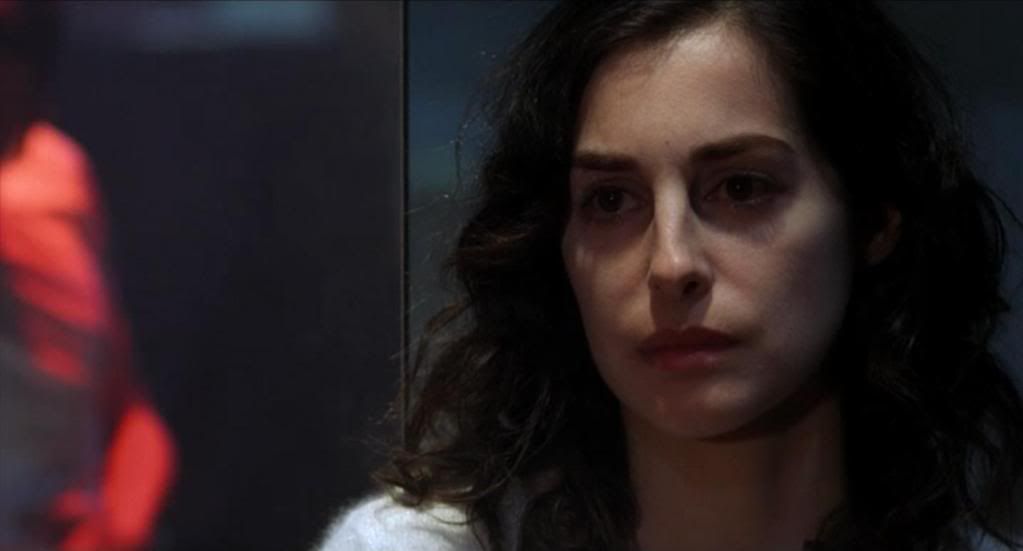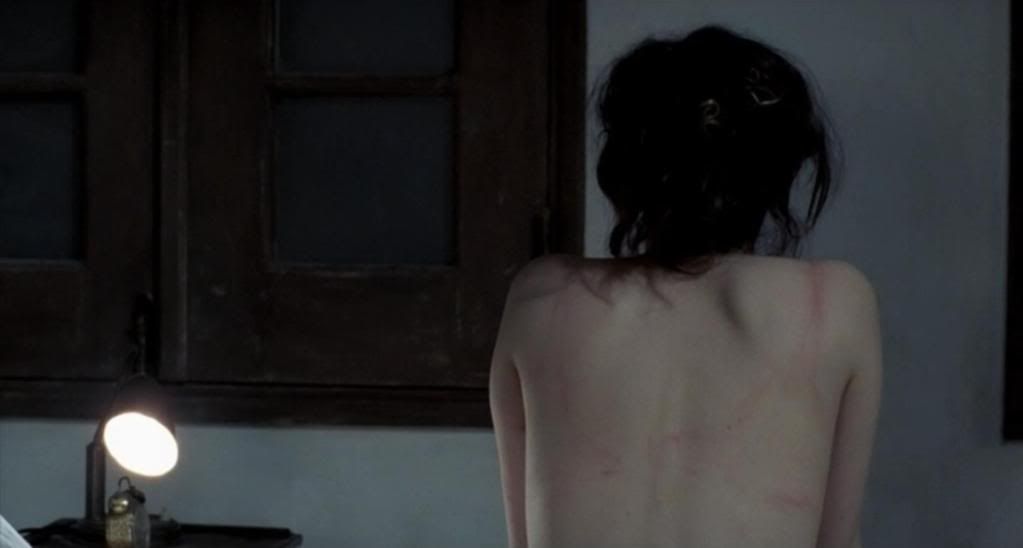
Catherine Breillat has never exactly been a subtle filmmaker, or a particularly easy one to grapple with. Her films are often bluntly provocative and polemical, using in-your-face, sexually explicit allegories to deliver her ideas about the essential antagonism between men and women. Anatomy of Hell is probably the ultimate Breillat film in many ways, a purely symbolic and abstracted confrontation between unnamed incarnations of female carnality and male brutality. It is also one of the director's worst films, a vile and simplistic work that wallows in its visceral images while advancing a rather nasty, limiting ideology that casts all men as vicious brutes, suggesting that while women are founts of life, men provide only death. It's familiar feminist rhetoric, here delivered in such exaggerated fashion that it seems grotesque, totally removed from anything that might shed real light on the nature of male/female dynamics.
Breillat, never one to shy away from provocative imagery, has still never seemed so eager to offend as she does here, piling on so many calculatedly confrontational images that the effect is numbing rather than challenging. The film's allegorical structure focuses on the relationship between a young woman (Amira Casar) and a gay man (Rocco Siffredi), who finds her cutting her wrists in the bathroom of a gay club. When he asks her why, she responds, "because I'm a woman," which is a pretty good indication of the level of discourse Breillat is working with here. Casar represents the eternally suffering woman, subject to the hatred and disdain of men, which leads her to hate herself, to hate and deny her body. In order to deal with these feelings, she makes a deal with Siffredi: she'll pay him to come to her house, where he'll look at her naked body and talk about women.

At the root of the film is the idea that men hate women, and that perhaps gay men hate women most of all — that last being an especially repulsive concept, suggesting that gay men wouldn't be gay if only they didn't hate women so much, if only they weren't so disgusted by what's between a woman's legs. The man is gay, Breillat theorizes, because as a boy he once killed a bird, in innocent cruelty, and now he permanently associates female genitalia with the slippery guts of the bird, spilling out beneath his sneaker. He finds women disgusting, intuitively linking sex and death, and linking womanhood with his own boyhood shame and disgust — disgust with himself, and with the little pink crushed bird who'd died. Breillat seemingly extrapolates from this situation to all men, suggesting that the straight man's contempt for women is simply a less extreme version of the gay man's total disengagement from female sexuality. Breillat often locates the formation of sexuality in childhood, although not always in such a crude, blunt way. But then this film is Breillat at her crudest and most blunt, pouring out a really quite remarkable stream of outrageous ideas in between visceral scenes of sex, closeups of a bloody vagina, and other scenes carefully calibrated to offend and shock.
The film suggests that the essence of male/female relationships is hatred and self-hate, disgust and violence. Casar says she knows that Siffredi wanted to kill her during the course of one night — when he'd stood over her threateningly with a gardening implement before turning it around and sticking its blunt end inside her instead, leaving it hanging out of her at a jaunty angle. According to her, and presumably according to Breillat as well, the desire to kill a woman is "an urge all men have, that's how they are."

Breillat is dealing with all this at such a simplistic level that she winds up simply repeating clichés and stereotypes about both men and women rather than really interrogating or overturning those kinds of received ideas. Her most overt provocations — like having Siffredi and Casar share a glass of water mixed with menstrual blood from a tampon — come across as almost comically overwrought, and there's also some (presumably unintentional) comedy to be found in Siffredi's wooden line readings. Since Siffredi seems to get the bulk of the film's most torturously overwritten philosophical observations, his stiff acting — he spends much of the film staring blankly into space — only makes the film even harder to take seriously. (There's probably a joke about "stiffness" to be made here.)
With Anatomy of Hell, Breillat sets out to deconstruct misogyny, to confront it head-on. Obviously, the intent behind the film's overt presentation of a woman's body, without eroticism, is to challenge and subvert the disgust that men supposedly feel at the idea of women's body hair and menstruation. Breillat seeks simultaneously to disgust and to suggest that what she's showing is not disgusting, a contradictory dual purpose that sabotages the film; she really achieves neither aim. Breillat has, in recent years, moved away from the overt provocation represented by films like this and Romance, instead crafting increasingly nuanced works that explore her familiar themes without relying so heavily on viscera and excess. Anatomy of Hell was her last film to date in this vein, and it's the grimy, ugly bottoming-out of this approach. There was no further, or lower, to go after this, and perhaps this film's slate-clearing vitriol is what made it possible for Breillat, in the years since, to move so decisively beyond this kind of shallow provocation to the genuinely fascinating, intellectually rigorous work she's been making ever since.
I'll have to take your word for it about her later work, cos I despised this film so much (I've been known to call it the worst film I've ever seen) it put me off Breillat pretty much forever. I'd hated Romance as well, and I likely would never have seen this had it not been the subject of a potential censorship controversy here in Australia; though it was passed with an R rating, the OFLC review board had been forced to review that decision, which meant it was likely to be banned. So one cinema here rushed it into release for a week before the decision was due to be handed down while it was still legal to show it, and that's the only reason I ever watched it. And then the R rating was upheld after all by the review board, so even the vague thrill of watching a film They Don't Want You To See evaporated...
ReplyDeleteShe's Andrea Dworkin come back from the dead!
ReplyDeleteGreat comment on the film ! Are you on twitter ? You can also share your thoughts with the hashtag #microcritik ! ;-) See you !
ReplyDeleteI am very fond of Breillat and enjoyed your analysis here, and I agree that Anatomy of Hell is one of her weaker films, not because of the subject matter but because of the dialogue. For me, Breillat's strength is in her visceral depiction of imagery and power and her control of actors. When they talk or meditate too much, she loses her punch--her brilliance resists verbal expression.
ReplyDeleteBut she made more subtle films before Anatomy of Hell too: 36 Fillette (one of my favorites), Brief Crossing, Sex is Comedy. Even Fat Girl (maybe her masterpiece) is far more nuanced in its portrayal of male malevolence. So I don't see her career as having as much of a trajectory--she tries out different voicings for her ideas, but they've been more or less in place since Un Vraie Jeune Fille (which I also quite like), and I don't see them as having evolved all that much.
At any rate, I recommend 36 Fillette in particular to her detractors, which should also make clear that she has very little in common with Andrea Dworkin. I think Breillat believes men are (sometimes) OK; she just considers them inferior.
Is this where I make the 'rakish hero' pun?
ReplyDeleteKidding aside, I think Anatomy of Hell is quite beautiful in its own way - Breillat's version of a ghost film.
Anatomy of Hell also seems to me to be Breillat's acknowledgement of just how limited the portrait of men in her films are.
ReplyDeleteThe various men in Fat Girl, Romance, 36 Fillette etc are what I'd call 'facilitators' almost willed into existence by the central female characters (even the more problematic male characters such as the rapists or murderers of Romance or Fat Girl). I guess you could even throw in Bluebeard himself from a later film in there too!
Anatomy of Hell in its detached chamber piece setting feels strangely more appropriate and insightful about this than the more 'realistic' films such as Fat Girl. Although for its celebrated long take deflowering sequence Fat Girl is in no way a 'realist' film, and because of that I've often thought that people make too much of a big deal about the shock ending negating the rest of the film. In a sense the ending is the inevitable end that the rest of the film was always foreboding - a teenage girl might feel like a terrible holiday might be the end of the world, so she conjures up (or invokes) a terrible end for everyone.
Yeah, yeah, weak storyline, bad film, strident politics, etc., and I guess I'm just weak, but I could stare at Amira Casar for a few nights, and I'd do it for free....
ReplyDelete